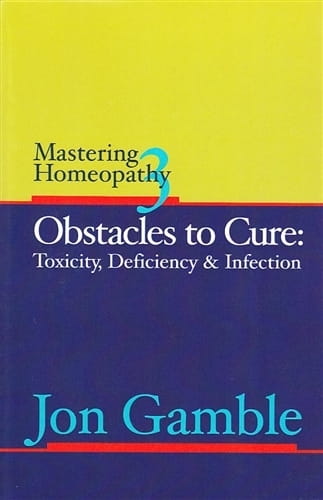Clinical outcomes are more certain
Gain confidence in treating chronic disease
Patient satisfaction is assured
We know who we are treating but how do we know what we are treating? If the patient has tingling in the extremities, do they just need a remedy? If that doesn't work what's next? We need to know what we are treating otherwise we are just guessing. Is the patients tingling caused by:
Calcium or magnesium deficiency?
Heavy metal toxicity?
Early diabetes?
Musculo-skeletal?
Knowing what we are treating takes out the guess work and makes remedy selection straightforward. Now you only have to choose from a small list of remedies for that condition, not an infinite materia medica. Clinical outcomes are therefore predictable. A definite treatment plan can then be discussed with your patient.
Mastering Homeopathy 3: Obstacles to Cure, by Jon Gamble and Nyema Hermiston, describes many of the modern obstacles to cure. The tests used to find these obstacles are identified and treatment solutions are suggested. As with previous books in this series, there are generous real case examples drawn from the practitioners combined 40+ years in practice.
Obstacles to Cure:
Mineral Deficiencies
Heavy Metal Toxicities
Iatrogenic causes (including Vaccinosis)
Infections and pathogens
Tests:
Hair Tissue Mineral Analysis
Conventional Pathology Tests
Other specialized (and less well known) Pathology Tests.
Consistent with other books in the series, this is a practitioner manual designed for use in clinical practice.
- Author: Jon Gamble
- ISBN: 9780975247334
- 192 pages
- Paperback
- Published in 2010
- Printed in Australia
Reprinted with the permission of The Society of Homeopaths from "The Homeopath" Journal, Spring 2011 edition, Reviewed by Margot Maidment.
I have not yet read volumes 1 and 2 in this series but, after reviewing this volume and based on its quality, I certainly intend to. We have all been confronted or at least heard about the difficulty of addressing 'stuck' or difficult cases and probably reflected on what may be preventing the case from progressing. Is our failure a result of not understanding or penetrating to the depth of the case? Worse, is it somehow the patient's 'fault' for not cooperating? (It is easy to stray into this dubious territory of blaming the patient if we don't guard against it.)
Gamble's work provides us with a much more satisfactory way of approaching the cases which 'challenge the efficacy of traditional homeopathic methodology'. He claims, based on his clinical experience, that we need to pay more attention to obstacles to cure. These may range from nutritional deficiency to iatrogenic causes. Having been already alerted to this possibility by my forays into nutritional therapy, I am delighted to find such a well-researched and comprehensive addition to my knowledge of this field.
This area of disease causation is not something that the average medical practitioner will have been trained for, nor what most homeopaths feel their initial training has prepared them well for, even if they are well aware of maintaining causes and the underpinning causes of disease. Gamble does not offer easy solutions and some of his protocols may be specific to his native Australia and more difficult to access here. However, he provides detail and clarity in both case-taking and analysis when explaining the history of his cases and their resolution is outlined with clear attention to why he adopts his strategies. These range from single high potency prescribing, to applications of tautopathy and isopathy in cases of chemical sensitivity.
This is a very persuasive thesis and offers a range of tools with which to address the varied presentations different patients may confront us with. Gamble suggests that we are being faced with 'a growing accumulation of toxic, infective and chemical agents which we have not evolved to deal with that need to be removed or excluded from the patient's environment before they can recover'. He points out that today's petro-chemical based substances did not exist in the 18th century and that there are 80,000 synthetic chemicals in daily use.
He explains some of his diagnostic tools as well as justifying his approach by reference to paragraphs in the Organon. From a business point of view, he says that as a result of the changes to his approach his practice has never been more exciting and his patients have never been better.
This is a slim volume but packed with references and supporting information as well as detailed case histories. It could revolutionise the practice of homeopaths in this country if we have sufficient open-mindedness, additional training and access to resources to support our approaches and it may well justify the extra efforts involved if we have the best interests of our patients at heart. It will not make our practices easier in the sense of the work involved and Gamble's assiduous approach is very evident in the cases he describes, but it may well make us more satisfied with the results we get from the work and time that we put in.

